![]()
contributed by Martina MacGreevy [Student Member of ASID & IIDA / interior design student—Rhodec International / design and composition student—Sessions NY]
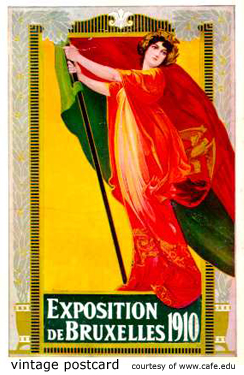 I have lived in Brussels, Belgium, for almost eleven years, and I’m still in awe of its diversity. It’s a diminutive city by any standard, but it’s also colossally cosmopolitan. Along with the three official languages (French, Flemish, and German), a host of other languages can be heard on the streets, owing mostly to the European Union and NATO headquarters located here. On my street alone, I live among French and Flemish speaking Belgians, Italians, Germans, Greeks, Spaniards, Lebanese, and Irish! Every possible culinary culture can be experienced in Brussels too. It is a chocolate connoisseur’s delight and boasts over 400 different beers. But there’s a lot more than food and drink to whet your appetite in Brussels.
I have lived in Brussels, Belgium, for almost eleven years, and I’m still in awe of its diversity. It’s a diminutive city by any standard, but it’s also colossally cosmopolitan. Along with the three official languages (French, Flemish, and German), a host of other languages can be heard on the streets, owing mostly to the European Union and NATO headquarters located here. On my street alone, I live among French and Flemish speaking Belgians, Italians, Germans, Greeks, Spaniards, Lebanese, and Irish! Every possible culinary culture can be experienced in Brussels too. It is a chocolate connoisseur’s delight and boasts over 400 different beers. But there’s a lot more than food and drink to whet your appetite in Brussels.
Celebrate Architecture
This year Belgium celebrates 175 years of independence and is paying particular attention to its Art Nouveau heritage as part of that celebration. Gothic, Neoclassical, Art Deco, and Modern buildings also abound in Brussels, and the city has planned many activities and guided walks to celebrate its architecture.
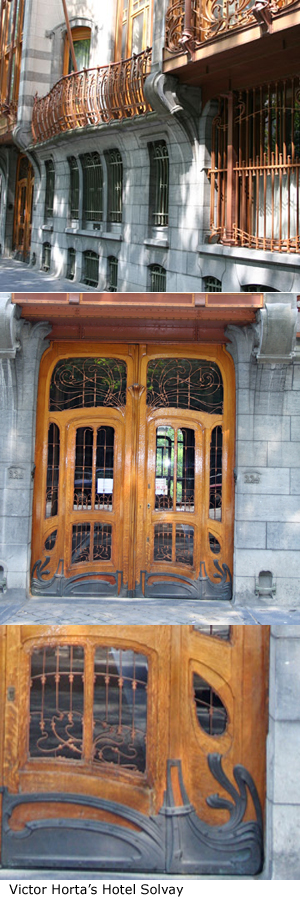 The most famous Belgian architect is, perhaps, Victor Horta, who delivered Art Nouveau to Europe. His house and adjacent studio, which he built in 1893, now comprise a living museum well worth visiting. Iron and steel and glass were used to create a light-filled and playful, but functional interior, matched by its delicate arabesque exterior.
The most famous Belgian architect is, perhaps, Victor Horta, who delivered Art Nouveau to Europe. His house and adjacent studio, which he built in 1893, now comprise a living museum well worth visiting. Iron and steel and glass were used to create a light-filled and playful, but functional interior, matched by its delicate arabesque exterior.
One of my favorite Horta houses is Hotel Solvay (pictured), commissioned in 1894 by industrialist Armand Solvay. It is situated on the glorious tree-lined Avenue Louise in central Brussels and is nestled between unremarkable office blocks, which just makes it even more significant. Art Nouveau style can be seen in all its splendor in the sinuous lines of the doorway alone.
Quartier Louise is where you’ll find Boss, Vuitton, B&B Italia, Baumann, Versace, Natan, Cartier, as well as boutique and luxury hotels. Cosmopolitan neighborhoods on either side of this avenue compete with great restaurants and weekly provincial food markets. Place du Châtelain is just one of these neighborhoods and is full of trendy cafés, restaurants, and Belgian brasseries. My favorite restaurant in this district is La Quincaillerie, which is housed in a former ironmonger’s shop that was built in the Art Nouveau style in 1903. The food is French brasserie style – a great selection of meat / game dishes, fish, seafood, and vegetarian fare– and you’ll also find a good wine. The ambiance is cozy and the service excellent.
Peruse the Avenue de Tervueren
On the west side of Brussels, on the tree-lined Avenue de Tervueren, you can admire an Art Nouveau masterpiece built in the Viennese Secessionist style. A local industrialist, Adolphe Stoclet, and his wife Suzanne commissioned the building in 1904 to house their extensive and renowned Asian art collection. Austrian architect Josef Hoffmann designed Palais Stoclet (pictured), including all its contents, and collaborated with Gustav Klimt on the murals. Unfortunately, it is not possible to visit the house.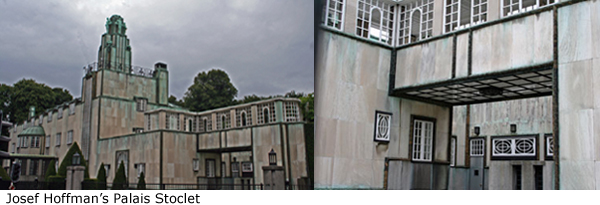
At the opposite end of the avenue is another work of genius. Paul Cauchie, an architect, painter, and decorator, is best known for his sgraffito work, a technique of scratching through one layer of plaster to reveal a second layer in a different color. His house (pictured), built in 1905, was an advertisement for his services. 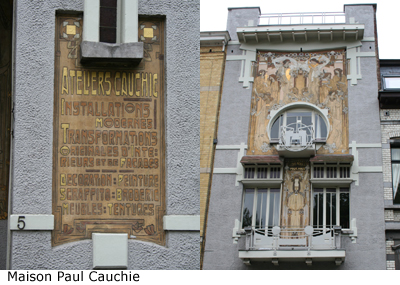 The façade, featuring a stylized female figure in combination with geometric and fluid organic forms, is similar to the work of Charles Rennie Mackintosh.
The façade, featuring a stylized female figure in combination with geometric and fluid organic forms, is similar to the work of Charles Rennie Mackintosh.
Not far from Maison Cauchie is a symbol of Belgium’s independence — Cinquantenaire Park. King Leopold II commissioned the park in 1880 to celebrate 50 years of independence. The triumphal arch (pictured), a gateway to the city at the time, is flanked on either side by the glass and steel exhibition halls, which house the airplane and auto museums. Two other attractions – the Museum of Art and History and the Army Museum – can be found on the grounds of the Park.
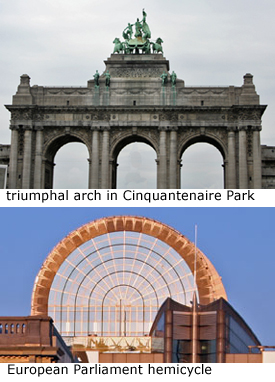 East of Cinquantenaire, many of the European Union buildings are situated in the area known locally as “the European quarter.” The most striking building is the European Parliament, designed by Michel Boucquillon, a Belgian architect. His auditorium, a hemicycle (pictured) built in 1988, embraces the concept of transparency.
East of Cinquantenaire, many of the European Union buildings are situated in the area known locally as “the European quarter.” The most striking building is the European Parliament, designed by Michel Boucquillon, a Belgian architect. His auditorium, a hemicycle (pictured) built in 1988, embraces the concept of transparency.
Shop and Dine
One of the main tourist attractions in Brussels is the Gothic and baroque town square, the Grand Place. The town hall was completed in 1455 and is surrounded by ornate guild houses (pictured), which were rebuilt at the end of the seventeenth century following an invasion by France’s King Louis XIV. While in the area, visit Chez Vincent to admire its original Art Nouveau interiors and dine on the very Belgian dish of moules frites, mussels and fries.
If luxury shopping is your thing, visit the Galeries St. Hubert, just a stone’s throw from the Grand Place. Opened in 1847, the Galeries (Galerie du roi and Galerie de la reine) boast the first glass and metal roof construction of its size in Belgium. The galleries are small but the shops are exquisite, featuring Neuhaus (chocolatier), Delvaux (renowned leather shop), jewelers, and brasseries. Before moving on, enjoy a coffee at the Art Deco Taverne du Passage.
For classical architecture, visit the Royal Palace and the surrounding area. The palace is open to the public from mid-July to September, and its interiors are striking, especially the Throne Room, which features bas-relief by Rodin.
One of the best places to spend a rainy Sunday is the old town area of the Sablon. After browsing the outdoor antique market and the various art and antique galleries, sit and ponder awhile at the widely acclaimed chocolatier / confectioner, Wittamers. Enjoy a coffee and a mouthwatering patisserie in the cold winter sunshine and admire the Gothic and neo-Gothic architecture of the Eglise du Sablon built in 1450 and renovated in the latter part of the nineteenth century.
Fashionistas should make their way to Rue Antoine Dansaert to savor the variety of local fashion houses that carry retro, vintage, and way-out chic. Dedicated fashion followers, however, must go north to Antwerp, the avant-garde capital of fashion. There, in the historic city center, they can visit ModeNatie, an initiative of the Flanders Fashion Institute.
Stroll, Tour and Attend
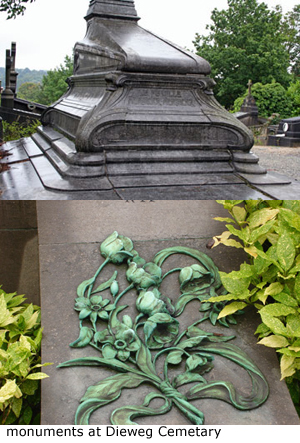 But back to Brussels and its architecture, or at least to the tombstones of the Dieweg Cemetery! Somewhat off the tourist trail and nestled in a wooded suburb south of the city, this cemetery contains the remains of many famous Belgians, such as Hergé, the creator of TinTin, and the Art Nouveau architect Paul Hankar. This haven of peace also contains many impressive monuments (pictured).
But back to Brussels and its architecture, or at least to the tombstones of the Dieweg Cemetery! Somewhat off the tourist trail and nestled in a wooded suburb south of the city, this cemetery contains the remains of many famous Belgians, such as Hergé, the creator of TinTin, and the Art Nouveau architect Paul Hankar. This haven of peace also contains many impressive monuments (pictured).
Back in the real world, the residential suburbs display their eclectic mix of townhouses — modern sits between Neoclassical or Art Nouveau or Art Deco. No two houses in any neighborhood are the same (pictured).
One might be forgiven for thinking of Brussels as a city that only celebrates its past, but a great contemporary design culture also exists. Every year in September, Brussels organizes a “Designers Week-End ” that is open to professionals and the public and introduces hot new contemporary designs. Over 20 designer outlets participate and visitors are guided through the city on a shuttle.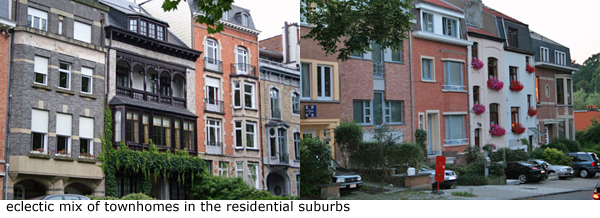
In addition to the renowned annual art and antique fair, Eurantica, designer exhibitions are the norm in Belgium throughout the winter months. For example, this month (August), the Brussels Expo is hosting the Europacado / Florex / Decoforce which showcases interior design and garden decoration. This major event is followed in September by the DecoContract, catering to those focused on contract design. The furniture fair Salon du Meuble, is held in November, followed quickly by Cocoon, an interiors fair. In Courtrai, situated in the west of Belgium, the international Interieur exhibition is held bi-annually in October.
Also worth mentioning is Creneau International’s gallery, which is situated close to the Sablon and is a platform for young architects and designers. Work is submitted to and thcen selected by Creneau International for exhibition and sale in its gallery.
Explore Some More
Brussels contains many great Art Nouveau buildings, and this article only highlights my personal favorites. Many other cities in Belgium have wonderful architecture as well, and I cannot end without mentioning Bruges’s incredible medieval structures. If you come to Brussels, be sure to book a side trip to Bruges to see its medieval marvels.
For additional information, click on the links below:
http://www.bruxelles-art-nouveau.be/
http://www.monarchie.be
http://www.quincaillerie.be
http://www.restaurantvincent.com
http://www.voiretdirebruxelles.be/
Except for the first image, all images copyrighted by Martina MacGreevy.


